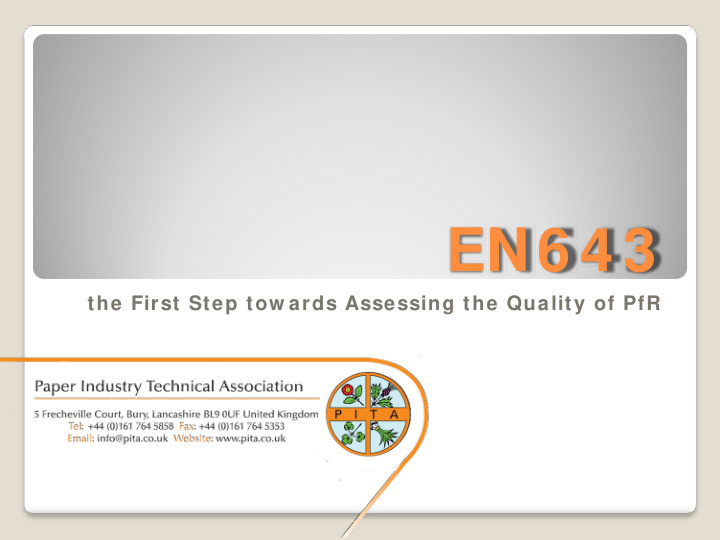



EN6 4 3 the First Step tow ards Assessing the Quality of PfR
EN6 4 3 I l Prim o Passo verso la Valutazione della Qualità del PfR
Paper for Recycling
Paper Recycling Source – CEPI Statistics 2012
W aste Paper is now Paper for Recycling � Waste Paper � Secondary Fibre � Recycled Fibre ( RF ) � Recovered Paper ( RP ) � Paper for Recycling ( PfR )
Paper for Recycling � Positives: • Valuable Raw Material • Globally Traded Product • Most Widely Used Raw Material in Europe � Negatives: • As ‘Recovery’ has increased, ‘Quality’ has decreased • Subject to Contamination � Solution: • Quality Standards needed!
EN 6 4 3 : 2 0 0 1 � Based on internal industry work by CEPI & ERPA finished in 1999 � Schedule (List) of Standard Grades of Recovered Paper & Board � Set no specifications � Published November 2001 EN 6 4 3 :2 0 0 2
6 6 grades of Recovered Paper 5 groups: � Group 1 : Ordinary grades � Group 2 : Medium grades � Group 3 : High grades � Group 4 : Kraft grades � Group 5 : Special grades EN6 4 3 :2 0 0 2
Specifications: � Only separate collection; Paper segregated from MRFs is not suitable for use in the paper industry � Defines unusable materials (non paper components plus paper and board detrimental to production) � No tolerance level (“supplied free of unusable materials”) � Maximum Moisture Content is 10% EN6 4 3 :2 0 0 2
EN6 4 3 :2 0 0 2 Global Trade:
EN 6 4 3 : 2 0 1 4 � Based on internal industry work lead by CEPI, ERPA, and FEAD starting in 2008 and proposed to CEN in Spring 2011 � Developed by the CEN Technical Committee and Working Group (TC172/WG2) between 2011 & 2013 � Formal voting process closed 29 th October 2013 � New Standard published March 2014! EN 6 4 3 :2 0 1 4
EN 6 4 3 : 2 0 1 3 - Main changes: � Recovered Paper (RP) � ‘Paper for Recycling’ (PfR) � Greater emphasis on content, rather than origin � Prohibited Materials – Zero Tolerance! � Unwanted Materials – Tolerance Levels Established • Non Paper Components – Typically 1.5% • P&B detrimental to production • P&B not according to grade definition • P&B not suitable for deinking grades (when intended for deinking) EN 6 4 3 :2 0 1 4
EN 6 4 3 : 2 0 1 4 - Main changes: � Use the European Recovered Paper Identification System is recommended � Recovered Paper Quality Control Guidelines, Responsible Sourcing Guidelines � Specific requirements for deinking grades e.g. � INGEDE Method 7 on visual inspection � Non-deinkable papers count as unwanted material � Shredding is recognised as an issue � Moisture content and how to measure it . . . . . . EN 6 4 3 :2 0 1 4
EN 6 4 3 :2 0 1 4 � As a step forw ards: • Significant Progress � As a technical standard: • Well, . . . . . . . EN 6 4 3 :2 0 1 4
MRF Quality – 1 8 Municipal MRFs ( UK)
Key I ssues � Sam pling: • No Standard Sampling Procedures are defined � Moisture Content: • No Test Method for Moisture content is specified � Contam ination ( Fibre/ Unw anted Materials) : • No Test Method for measurement of Contamination is specified EN 6 4 3 :2 0 1 4
China’s Green Fence � Tightened enforcement of existing regulations � Product bound for Chinese recyclers checked at the point of import and the point of origin. � Officially ended, but continues EN 6 4 3 :2 0 1 4
Sam pling: � Sam pling of Loose Material � Sam pling of Baled Material � Sampling of Loads / Consignments � Automated Sampling • Balemate (PTS) – Probe Insertion • Monitor (CTP)- Sample Extraction EN 6 4 3 :The Future
Sam pling: � Ensure a Representative Sample � Recovered Paper is intrinsically Non- Homogenous � Sampling Procedure should not influence results (Different Techniques Grade / Test) � Draft Discussion Document drafted EN 6 4 3 :The Future
Sam pling: � Manual Sampling: � Requires a robust sampling strategy for meaningful results; relies on historical trends � Automatic Sampling: � Capable of extensive sampling � Does not measure all parameters specified in EN643 � Draft Discussion Document drafted EN 6 4 3 :The Future
Specified Param eters: � Moisture Content � Fibrous Cross Contamination � Non-Fibrous Contamination � Future Requirements EN 6 4 3 :The Future
Moisture Content: � Robust Laboratory Technique • Typically Gravimetric / 105 C / Constant Weight � Practical, yet Reproducible, Field Technique • Microwave Drying (?) � Sensor Techniques � Discussion Docum ent EN 6 4 3 :The Future
Contam ination: ◦ Fibrous Cross-Contam ination � e.g. Brown Fibre in White Grades ◦ Non-Fibrous Cross-Contam ination � e.g. Plastics / Glass / Grit ◦ Detrim ental Contam ination � e.g. Difficult Inks in Deinking Grades ◦ Chem ical Contam ination � e.g. Mineral Oils ◦ Future Requirem ents EN 6 4 3 :The Future
EN 6 4 3 :2 0 ?? The Future
Future Developm ent: ◦ TC1 7 2 / W G2 � Bound by CEN Procedures � Engage with ALL Stakeholders in the PfR Value Chain � Foundations for NEXT Formal Revision (2018?) � Note Demands of Non-European Markets EN 6 4 3 :the Journey tow ards Quality PfR
Thank You
Recommend
More recommend